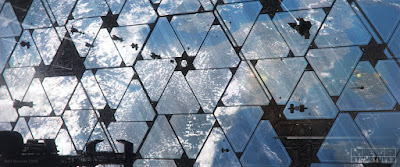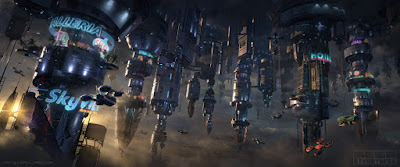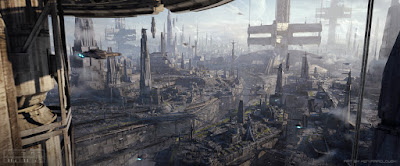I have several other personal IPs in development, here's another sneak peek at "Ship Jumper". Another universe to play in after I hand the Megastructures book into the printer.
Art Director & Senior Concept Designer in Film, Games, Books, Tech. Builds Scifi Worlds. Professional Work: Pixar Alum (16 Yrs), Blur, WarnerMedia, ++
Wednesday, July 28, 2021
Tuesday, July 20, 2021
The Kickstarter Is Done!
Wow! The average kickstarter usually sees a spike in sales on the last day, but we made a surprising 10% of our money in those final 24 hours, only beaten by getting 20% of our sales in the first 24 hours. The final tally, 503% funded, and almost 1000 books sold! Thank you so much to everyone for all the support, the kickstarter was a tremendous success, and is now fully funded and finished. I'm excited to move onto the next stage: getting the books out!
For those of you who pledged, I'll be sending out regular updates on the current stage of the process. And I'll drop a few photos and tidbits on my other social media platforms for all to see as well, stuff like the printed proofs and the postcards and other rewards as they get manufactured. Thanks again to all!
Megastructures Undersea Habitat 1
An Underwater Habitat would be a below-water structure where humans could live for extended periods of time and perform everyday activities such as eating, sleeping, and working. Today’s Underwater Habitats are generally meant for short-term visits by scientists, but in the future we could potentially create entire cities where residents could remain for their entire lives.
The habitat would likely be a set of smaller, interconnected modules made from steel, glass, and cement, rather than a single giant glass bubble. This would help prevent some of the dangers that could be caused by a single bubble breaking under sea pressure. It would also allow for easy habitat expansion, and should a leak occur, it would be easier to isolate and then repair the affected area. Units could potentially be built on the surface and then sunk, since construction would be easier on the surface.
Thursday, July 15, 2021
Megastructures Space Farm 2
One of the main needs of a space habitat’s population would be food. While many habitats could reserve internal areas for farming, farmlands could also be attached to the habitats in connected structures. Other options would include internal food production such as vertical farming, or creating exterior movable platforms, like floating farms in space.
Zero-g plants would be placed on the platforms, with enclosures to retain atmosphere. A highly controlled environment would mean factors such as temperature, humidity, soil, light, and atmospheric gases could be customized specifically to achieve the highest crop yield, which would be harder to achieve in a mixed-use situation where crops and human populations coexisted inside a single habitat.
Lighting could be artificial inside the platforms, or a set of mirrors could be used that would reflect real sunlight, creating a fake day/night cycle. Seasons could be simulated as well.
As a population grew, more of these floating islands would be created and added to the cluster. Giant tug robots could move the islands to new locations, or even bring one back to the space station for repair, or at harvest time to unload its yield. The farms could be entirely automated with robot gardeners, or have a small population of humans looking after the crops.
And if you like this sort of artwork, please check out my new book project "Megastructures: The Visual Encyclopedia" here:
Wednesday, July 14, 2021
Week #4 Of Megastructures Kickstarter
This week we surpassed Stretch Goal #5, which unlocked a pdf reward tier for the project. We're almost at 400% funded, which will unlock Stretch Goal #6, and with less than a week to go, I think we're going to just make it :)
Thank you everyone for all the support so far, and if you haven't pledged yet and find this project at all interesting, now's the time. While there may be a couple of extra books for online sale after the kickstarter is done, I'm basically going to print enough copies for the kickstarter folk and a few for conventions and that's it, so if you want the book, now's the time to reserve your copy!
Thanks again, you guys rock!
Megastructures Worldhouse Roof 2
A Worldhouse Roof would involve the construction of a habitable enclosure which would grow until it covered an entire planet.
The enclosure would be a thin, strong, flexible, and transparent roof, or membrane, held up at least 1 km above the planet’s surface. Its purpose would be to allow sunlight in and keep the atmosphere from leaking out.
Once constructed, the interior of the membrane would then be pressurized with a breathable atmosphere, allowing you to terraform almost any planet or asteroid. At smaller sizes, this could also be thought of as a domed city. The membrane would be held up by towers and cables spaced regularly along the planet’s surface, or could potentially be held up using atmospheric pressure.
And if you like this sort of artwork, please check out my new book project "Megastructures: The Visual Encyclopedia" here:
Thursday, July 8, 2021
Megastructures Fusion Candle 7
A Fusion Candle would be a giant engine that could potentially be used to move a gas giant planet to a new location. The engine would be placed deep inside the clouds of the gas giant. Intakes would inhale the gases (presumably hydrogen), funneling them to a giant fusion reactor, then light up the engine on both ends (a candle burning at both ends). One end would point toward the gas giant. The second would point out toward space. If kept in perfect balance, the end pointing toward the planet would keep the engine floating in the atmosphere, and the end pointing toward space would push the planet forward.
And if you like this sort of artwork, please check out my new book project "Megastructures: The Visual Encyclopedia" here:
Wednesday, July 7, 2021
Week #3 Of Megastructures Kickstarter
This week we surpassed Stretch Goal #4, and now every book will include a Megastructures postcard (1 random design of a possible 6). Only 2 weeks left to go, at its current rate, I suspect we may reach as much as 400% funded, which is a dream come true. Thank you everyone for all the support!
And here's two new Megastructure pieces from the guest artists, the first is a Ceiling City by the amazing Andy Proctor https://www.artstation.com/andyp, and the second a planet scaled city Ecumenopolis by Ken Fairclough https://www.artstation.com/kenfairclough
Monday, July 5, 2021
Megastructures Hoopworld 1
The Hoopworld is right on the edge of the possible, but according to my research the science isn't pure fantasy.
A
Hoopworld would be a structure that would place humans on the outside
surface of a giant spinning torus, or donut. A Hoopworld could
potentially have many different shapes, depending on the length of the
revolution axis and the radius of the circle being revolved.
Different-shaped tori would also affect gravity, the day-and-night
cycle, and weather conditions.
The hoop would be spun along the
axis of revolution to produce gravity and stabilization, and to provide
night and day to different areas on the torus. Gravity would first
depend on the amount of mass on the interior of the hoop, and would
likely require an active support structure. Second, since the hoop would
be spinning, centrifugal force would cause stronger gravity on the
inner equator, since you’d be pulled toward the outside of the hoop in
the direction of the ground. The outer equator would have less gravity,
since you’d be pulled toward the outside of the hoop in the direction of
the sky.
Tipping the torus toward or away from the sun would
create seasons, affect weather, and could create a wide variety of
climates over different parts of the torus’ surface.
And if you like this sort of artwork, please check out my new book project "Megastructures: The Visual Encyclopedia" here:
Thursday, July 1, 2021
Megastructures Topopolis 1
A Topopolis would be a tube-shaped space habitat that would loop into a
ring with a star at its centroid, or could be looped several times
around the star to create a “Torus Knot.” Inhabitants would live on the
inside of the structure, with gravity provided by the tube rotating
along its radius, instead of rotating around its centroid like in a
Ringworld. Another way to imagine a Topopolis is as a set of thousands
of O’Neill Cylinders formed into a chain. Bend the chain to form a
circle around the star, and the individual cylinders would rotate the
same way a standard O’Neill Cylinder would to create gravity.
If the Topopolis’ inhabitants looked along the axis of revolution, they
would see what appeared to be a cylinder going off into infinity. In
fact, the cylinder would gently curve as it traveled farther from the
viewer, but the size would be so massive that you wouldn’t be able to
notice the curve. A train traveling in a full hundred-million-kilometer
circle could be set into the middle of the land.
And if you like this sort of artwork, please check out my new book project "Megastructures: The Visual Encyclopedia" here:
https://www.kickstarter.com/projects/artofsoulburn/megastructures-the-visual-encyclopedia-book-project










